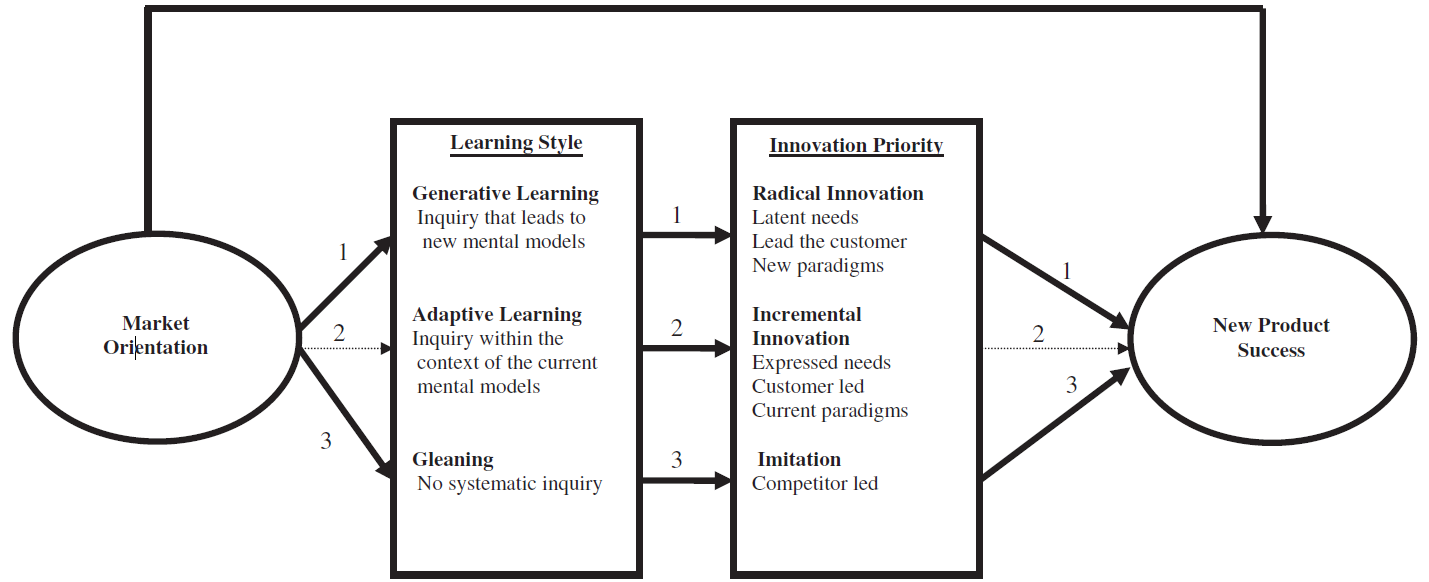 Three market orientation–learning style–innovation–new product success paths.
Three market orientation–learning style–innovation–new product success paths.
Market orientation is expected to be positively related to generative learning (1)
and negatively related to gleaning (3)
but is not expected to be related to adaptive learning (2)…
Serving customers best still takes incremental innovation
…market orientation may be characterized as ‘‘ pervasive commitment to a set of processes, beliefs, and values reflecting the philosophy that all decisions start with the customer and are guided by a deep and shared understanding of customers’ needs and behavior, and competitors’ capabilities and intentions, for the purpose of realizing superior performance by satisfying customers better than competitors’’…
Although market-oriented firms are expected to be adept at adaptive learning inspired incremental innovation,… it is expected that this will also be true of most firms regardless of their market orientation.
Typically, innovation takes the form of brand or line extensions, modifications to existing products, or repositionings. There is a comfort to the learning and innovation that takes place in this mode because organizational members are not questioning the successes of the past. They are merely improving on them.
Although the results show that this type of innovation is the most common and least variable in the sample of firms, they also show that it is not related to market orientation. Incremental innovation was the most common form of innovation in firms. The priority firms place on it, however, was not related to new product success.
Serving customers best requires more radical innovation, and less imitation
In general, radical innovations have greater value to firms than incremental innovations, particularly when radical innovators have deep pockets and strong market power… New product concepts have greater value than line extensions… and technological breakthroughs are more profitable than incremental improvements… [Researchers] reported… product advantage and product innovativeness—two correlates of radical innovation—to be strongly related to new product success. Radical innovation priority was positively related to new product success; imitation priority was negatively related to new product success.
Market orientation had a direct positive relationship with new product success. Market orientation also had a positive indirect influence on new product success through generative-learning-inspired radical innovation and a negative indirect influence on new product success through gleaning-inspired imitation. Market orientation had no influence on firms’ adaptive learning priority or incremental innovation priority.
Overall, the results suggest that market orientation shifts the weight of a firms innovation programs away from imitation toward a balance between incremental and radical innovation.

Serving customers best requires new learning and experimenting
Maximal long-term success requires a two-pronged innovation strategy.
In the short run, firms must remain competitive and alluring by engaging in incremental improvements that appeal to their customer base. These types of innovations can be discovered and prioritized by talking to customers and by monitoring competitors through traditional marketing research and intelligence activities.
In the long run, however, the most successful firms accompany adaptive modifications to the marketing mix with framebreaking initiatives. …long-term market leaders must innovate relentlessly and must be willing to cannibalize their own products to maintain their leadership position. These initiatives must be proactive and planned and must encourage employees to be selectively destructive (e.g., to identify and undo the obsolete). Although short-run incremental innovation programs can be linked explicitly to deadlines, budgets and outcome measures (e.g., ROI), longer-run destructive programs are not likely to produce results in a linear manner. As a result, they may best be pursued offline.
…a strong market orientation appears to be a key to the ability of firms to balance incremental and radical innovation programs. Prior research has also identified learning orientation as a key element of this process.
Managers should strive to improve their market and learning orientations by diagnosing their performance on each and benchmarking progress relative to exemplar firms.
In addition, long-run radical innovation requires firms to foster the motivation, opportunity, and ability to implement change…; in other word culture is key…
- Motivation can be instilled by a reward system that makes experimentation and failure psychologically safe and the maintenance of the status quo psychologically unsafe.
- Opportunity requires that employees be given the money, time, and voice to engage in change related behaviors.
- Ability requires firms to hire the right type of people: ‘‘Individuals with low needs for uncertainty avoidance, high tolerance for ambiguity and the lust to experiment should be recruited for decision-makers’’…
- Baker, William E., and James M. Sinkula. “Does market orientation facilitate balanced innovation programs? An organizational learning perspective.” Journal of product innovation management 24.4 (2007): 316-334.